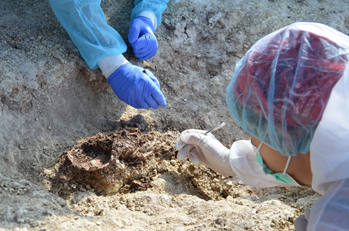Using AI to control energy for indoor agriculture
30 September 2024
Published online 16 January 2018
Mitogenomes reveal that women were on the move in the Mediterranean in the 1st millennium BCE.

© Michele Guirguis
The Phoenicians, renowned sailors and traders with origins in Lebanon from c. 1800 BCE, left their homeland in the 9th century BCE and spread through the Mediterranean with settlements in the Iberian Peninsula, North Africa, and Italy. However, little is known about these expert mariners due to the limited numbers of documents written in their own language.
Pierre Zalloua, study senior-author and geneticist at the Lebanese American University, Byblos, Lebanon, and his team analyzed 10 samples of ancient DNA (aDNA) found in teeth from Phoenician tombs in Monte Sirai, Sardinia (c. 700 – 400 BCE) and four samples from pre-Phoenician (ca. 1800 BCE) and Phoenician sites in Lebanon to reveal the genetic footprint of the Phoenicians in the Mediterranean.
Lisa Matisoo-Smith, the study’s lead author, at the University Otago, Dunedin, New Zealand used next-generation sequencing technology to sequence their entire mitochondrial genomes, inherited maternally, providing a lineal relationship of female ancestry.
The key to understanding population movements is tracking changes in the distribution of haplogroups over time. Matisoo-Smith explains that haplogroups are made up of “DNA sequences that share mutations that put them on the same extended branch of a family tree.”
The recent surge in aDNA studies of populations in Europe and the Near East has enabled researchers to “get a good picture of where different lineages were likely to have emerged and when, and how they spread,” Matisoo-Smith says.
When compared with 21 published pre-Phoenician samples from Sardinia, the Phoenician mitogenome sequences reveal a complex story: some haplogroups continue from the indigenous population, but different haplogroups linked to lineages in the Near East or North Africa and even as far away as the British Isles or Northern Europe also cropped up. Likewise, some of the Lebanese Phoenician samples contain haplogroups from southwest European lineages.
These results suggest a multi-cultural and mobile society where women from the Near East and/or North Africa moved to Sardinia and mixed with the local population. Likewise, southwestern European women moved to Lebanon and inter-mingled with indigenous groups.
Zalloua points to a degree of genetic continuity, “the people who migrated and stayed there actually became part of the Sardinian culture. Suggesting that there was a level of mobility, whereby they would bring women from these settlements in Europe and bring them back to Lebanon and vice-versa.”
Excitingly, these results “may represent the mobility of women through the wider Phoenician trade networks, indicating that women and children played an active part in the growth processes of the new Mediterranean communities until the Roman era,” according to Michele Guirguis, an archaeologist at University of Sassari, Italy, who was involved with the study.
Connie J. Mulligan, professor at the University of Florida Department of Anthropology and Genetics Institute, who was not involved in the study, says the Sardinian samples demonstrate the high levels of genetic diversity in the region. Mulligan cautions that, “with the relatively small number of individuals sequenced and the relatively short time depth represented, the mitochondrial genome’s narrow maternal lineage limits the statements the researchers can make.”
Marc Haber, a post-doctoral fellow at the Sanger Institute adds, “this study presents a fascinating story, which should be confirmed by sequencing the more informative nuclear genomes from ancient individuals throughout the Mediterranean.”
While Matisoo-Smith recognizes that sample sizes can be a challenge, and cites the high cost and difficulties of aDNA preservation in hot climates, “sequencing ancient mitochondrial DNA definitely gives us an indication of somebody carrying that lineage existed at that place at that point in time.”
Zalloua says this study is the first part in a bigger project; the team started with mitochondrial DNA, given its abundance over nuclear DNA in ancient samples, and is working towards sequencing the nuclear genome of ancient Phoenicians to provide more data.
doi:10.1038/nmiddleeast.2018.4
Stay connected: